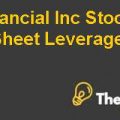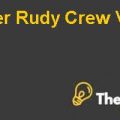Gulf Oil Corporation-Takeover Case Study Solution
Profits from Gulf’s Acquisition
The potential profits for the acquirers could be determined by estimating the value per share of Gulf and comparing the value with the minimum bid price. A Perpetuity Valuation assuming that the company would benefit the acquirer for an infinite time period could be helpful in finding out the enterprise value of Gulf. The perpetuity valuation is conducted by using the data provided in the Exhibit 1 of the case. Using this data, the enterprise value on the basis of perpetuity equals to $18726 million. Moreover, as the Exploration and Development programs also possess a positive NPV and could benefit the acquirer, therefore, the NPV of the E&D programs are added in the enterprise value. The equity value after subtracting the debt, equals to $20347. By using the data, the value per share of Gulf on the basis of Perpetuity Valuation equals to $123, which implies that, at an offer price of $70 per share; the acquirer would earn 43% as a discount on shares purchased.
Note: all the related calculations are provided in Appendix 2.
Optimal Bid Price Levels for Socal
The optimal bid price levels for Socal include the minimum level of $75 per share, as the close rival in the bidding process i.e. ARCO, could offer a maximum bid price of $75 per share. So in order to win the bid, Socal must consider a minimum bid price level of $75 per share. However, the maximum bid price level could be estimated at a point where there is a difference between of NPV between the Equity value of the firm and the acquisition price. The NPV form the acquisition would be zero at a price of $123 per share,which implies that the firm could offer a minimum bid price of $75 per share, and a maximum bid price of $123 per share.
As intended by the company; if the Gulf takeover is financed by acquiring the debt of $14 billion dollar, the firm will have to pay the debt in few years in order to reduce the leverage. This could happen in two ways, which are;Gulf would either have to sell off its assets or end the E&D program. After this, the company could utilize the amount for paying the debt. However, E&D program has a potential positive NPV, therefore, the firm is recommended to choose to pay the debt by selling Gulf’s assets in an opposition to end up the E&D program.
Although, the acquisition would allow the company to take various advantages in form of extending reserves and increase in firm’s value etc, but, the acquisition would pose certain threats in the form of increase in the firm’s leverage. The firm might face certain problems in future regarding paying the debt acquired for acquisition,which could pose a severe threat of the firm’s liquidation. Moreover, all of the valuation conducted for Gulf are based on the economic benefits,which are incalculable. It implies that the value estimation could be proved inefficient due to the nature of the acquisition.
Despite of these threats; the value provided by the Gulf is higher, and the company would be eligible to consider the acquisition even after having the possibilities of facing various risks attached with the acquisition.
Note: all the related calculations are provided in Appendix 3.
Recommendations
On the basis of the above analysis, the company is recommended to acquire the Gulf Oil Corporation at a bid price ranging from $75 to $123. The acquisition would provide an access to the vast quantities of high quality light oil to Socal. Moreover, it would double its reserves in a single night,which ensures the long term viability of the firm’s existence. However, the firm has to bear a considerable amount of financial leverage after combining, and would be required to reduce the leverage in few years either by selling Gulf’s assets or by utilizing the money earned from exploration and development i.e. 2 billion 1983. In this regards, as the E&D program has a potential positive NPV, therefore; the firm is recommended to pay the debt by selling the Gulf’s assets rather than by calling off the E&D program.
Conclusion
Although, the bid price demanded by the Gulf Corporation is much higher than the current market price of the share, but, the valuation of the firm conducted by using perpetuity method shows that the net value for the firm, including the value of E&D Program equals to $123 per share. This implies that the acquisition could bring in substantial amount of cash flows along with the extensive oil and gas reserves.
Exhibits
Exhibit-1: NPV Calculations
| NPV of Exploration and Development Program: | |
| Total Exploration Cost 1982 | 2646 |
| Total Exploration Cost 1983 | 2189 |
| Average Exploration Cost | 2418 |
| Barrel produced | 375 |
| Operating Profit Total in 8 years | 1928 |
| PV of Tax Shelters Exp'd | 629 |
| PV of Tax Shelters Cap'd | 1673 |
| NPV of 1 year of Exploration and Development | 1813 |
| Nominal Growth Rate | 5% |
| Discount Rate | 20% |
| NPV Exploration and Development Program | $12458 |
Exhibit-2: Gulf’s Valuation
| Perpetuity Valuation for Gulf: | |
| Revenues | 6503 |
| Less Costs: | |
| Production | 911 |
| Wellhead taxes | 792 |
| Depreciation Expense | 1000 |
| Other operating Expenses | 351 |
| EBIT | 3449 |
| EBIT*(1-Tax) | 1725 |
| Add: Depreciation | 1000 |
| Free Cash Flow | 2725 |
| Enterprise Value (perpetuity) | 18726 |
| Valuation With E&D | |
| Value of Exploration and Development Program | 12458 |
| Total Enterprise Value | 31183 |
| Less Debt | 10836 |
| Equity Value | 20347 |
| No. of Outstanding Shares | 165.3 |
| Value per share | 123 |
| Price offered | 70 |
| discount (Premium) on shares | 53 |
| Rate of Return | 43% |
Exhibit-3: Optimal Bid Price
| Optimal Bid Price Levels: | |
| Minimum Bid Price Level | $75 |
| Maximum Bid Price at NPV=Zero | |
| Cash Outflow for purchases = Price * No. of Outstanding Shares | |
| At 0 NPV, | |
| Cash Outflow for purchase = Enterprise Value | |
| Enterprise Value (Equity Value) | 20347 |
| No. of Outstanding Shares | 165.3 |
| Maximum Bid Price Level | $123 |
This is just a sample partical work. Please place the order on the website to get your own originally done case solution.











